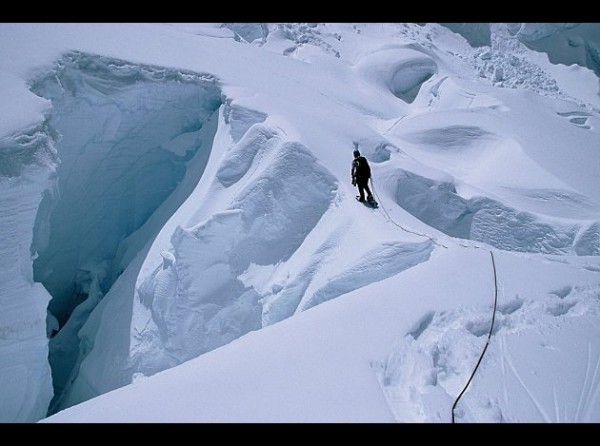« 2011, Neiges et Glaces du Monde » (2011, Snows and ices of the world) is a project of Marion Jonchères, French mountaineer, sportswoman, adventurer to the end of the world. During a full year, this frail young woman will face cold and altitude while climbing icy summits all over the world, on all continents.
But Marion is also a photographer ; This is why we asked her to share her tips and tricks with us for a better photography in (high) altitude. They will be applicable under 6000m too, of course.
You can follow her 2011 adventure on her blog at ice-altitude.com.
When Yves asks me about the peculiarities of mountain photography, I ask back: What mountain photography? The pictures of the admiring tourist using his photo camera from an outdoor café facing the snowy peaks? Maybe not… Or the pictures of an assiduous practitioner, whose camera is a part of the mountaineering gear? Of course, this goes with some constrains… Here are the lessons I draw from my modest amateur experience.
-
- Focus on a camera body as compact and lightweight as possibleDon’t forget that you must carry the photo gear and that it must not limit your progression. The photo hardware is stored in the backpack or carried, inside the clothes or on a shoulder strap. Forget about sensitive equipment!
If you leave for a trekking or a long expedition, remember the spare batteries or solar battery chargers. The most farsighted mountaineer will have several memory cards, just as insurance against losing all the pictures in case of the long fall of the camera into a crevice or a river… - Use a UV filterUltra-violet (UV) light density will increase with altitude. Snow has a blinding effect. The UV filter (Skylight 1A or 1B) helps moderate these effects. Moreover, it will protect the lens if, like I do to speed up operation, you never cover the lens between shots.
- Favor a wide-angle lens and leave the telephoto homeA wide-angle lens (up to 18 mm) will allow to step back from the somewhat imposing mountains and will better capture your feeling in front of a mountain range… Sometimes, one would wish being equipped for panorama photography!To capture pictures of your climbing partner in action, forget the telephoto lens except if you intend to check on his ice spikes or his climbing helmet. However, a slightly longer focal length (135 mm) is useful to isolate an individual while keeping some image depth.
And if you want to track the progress of your partners on a mountain side or define an itinerary, you’d better have binoculars ; It’s less heavy and more powerful.
- Of the difficulty to capture the actual inclination of a rock / snow / ice slopeThe rock wall is vertical and snow slope is inclined to more than 60 degrees, and your leader, above you, still seems to be crawling on all fours? This is the main difficulty for a picture or the progress of your leader. You’d better try to shoot pictures of a person roughly on the same level as you (be sure to catch his best profile!), the sky or other mountains being a background to highlight the position of your model and the slope he/she’s working on. Some low angle shots may be successful too if you keep composition lines or a focal point (an ice tongue or a moraine…).
- Focus on a camera body as compact and lightweight as possibleDon’t forget that you must carry the photo gear and that it must not limit your progression. The photo hardware is stored in the backpack or carried, inside the clothes or on a shoulder strap. Forget about sensitive equipment!

- Forget about back-lightingExcept if you want to draw the different planes of ranges up to the horizon, mountain is usually quite ugly when back-lit, crushed in light, rock will become black, without any of the contrasts brought by a more favorable lighting.
- Which is the nicest light?Very personal question… If the sunsets can give you magnificent colors, most notably in rosy tints, still prefer the colors of sunrise. The morning orange will be warmer than in the evening and the atmosphere will be clearer. Also notice with interest the pastel lights so peculiar in a Winter afternoon, drawing into apricot or peach: Quite a treat (figuratively speaking)!
- To dazzle your friendsYou just climbed a snow couloir still somewhat unimpressive? So, climb down quickly and shoot the couloir while facing it from a little distance: Your friends may feel that it is now near vertical!
- Despite all your talent and the quality of all your gear… be ready for frustration!Stopping to get your camera out of your jacket will quickly become annoying when you also have to concentrate on your progress. How many times did I feel I had shot 100 pictures to discover only 30 in the camera when the climb is done and most of them uninterested or not spectacular enough or not worth taking… It is somewhat hard to simultaneously climb, admire and shoot! Choose your partner cautiously: On top of his mountaineering qualities, he must be patient to stop whenever you want and whenever the safety conditions are met (certainly not under a serac or in the middle of a snow bridge…)
